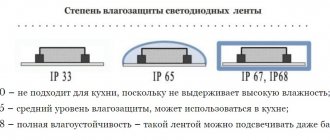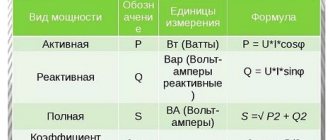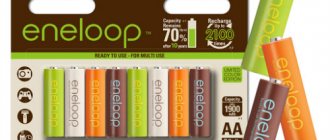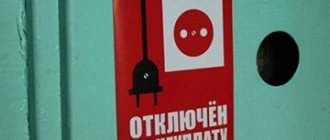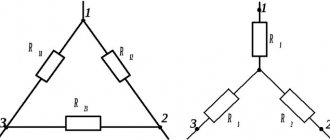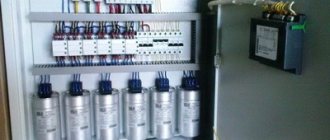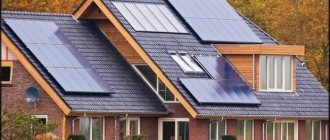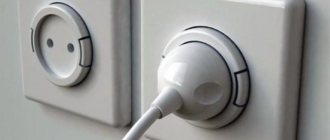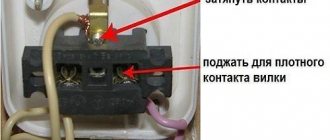General data required for calculations
The more powerful the electric heater, the faster it heats a given amount of water. Therefore, devices for this parameter are selected in accordance with the tasks, the required volume and the allowable waiting time. So, for example, heating 15 liters to 60°C with a 1.5 kW heater will take about an hour and a half. However, for large volumes (for example, to fill a 100-liter bath) with a reasonable waiting time (up to 3 hours), a device 3 kW more powerful will be needed to bring the liquid to a comfortable temperature.
To fully calculate the design power, it is necessary to take into account a number of parameters:
Calculation of the frontal cross-section of the device required for the passage of air flow
Having determined the necessary thermal power to heat the required volume, we find the frontal cross-section for air passage.
Frontal section is a working internal section with heat-dissipating tubes through which flows of forced cold air directly pass.
f
(m.sq.) =
G
/
v
where:
G
- mass air flow, kg/hour
v
- mass air velocity - for finned heaters is taken in the range of 3 - 5 (kg/m.sq.s). Acceptable values - up to 7 - 8 kg/m.sq.s.
Storage water heaters (boilers)
Without physical and mathematical formulas, a household calculation is described as follows: in 1 hour, 1 kW heats 860 liters per 1 K. To more accurately determine the heating time, power characteristics, and volume, a universal formula is used, from which the remaining results are then derived:
This formula consists of several and reflects a number of parameters, taking into account the heat loss factor. (With low power characteristics and large volume, this factor becomes more significant, however, in household heaters this accounting value is often neglected):
N full – power characteristics of the heating element,
Q c – heat loss of the water heating tank.
- c= Q/m*(tк-tн)
- C – specific heat capacity,
- Q – amount of heat,
- m – mass in kilograms (or volume in liters),
- tк and tн (in °С) – final and initial temperatures.
- N=Q/t
- N – heating power characteristics.
- t—heating time in seconds.
- N = N full — (1000/24)*Q c
Simplified formulas with a constant coefficient:
- Calculation of the power of the heating element for heating water at the desired temperature: W= 0.00117*V*(tk-tn)/T
- Determination of the time required to heat water in a water heater: T= 0.00117*V*(tк-tн)/W
Formula components:
- W (in kW) – power characteristic of heating elements (heating element),
- T (in hours) – water heating time,
- V (in liters) – tank volume,
- tк and tн (in °С) – final and initial temperatures (final – usually 60°C).
Volume is often equated to mass (m). Then the power of the heating element will be determined using the formula: W= 0.00117*m*(tk-tn)/T. The formulas are considered simplified, also because they do not take into account:
- actual power of the electrical network,
- ambient temperature,
- design features and potential heat loss of the tank,
- recommendations of some manufacturers regarding temperature (about 5-8 °C in summer and 15-18 °C in winter).
When purchasing a device, you must take into account that the relatively low power characteristics of storage water heaters compared to instantaneous water heaters do not yet guarantee financial savings. Savings ones “take away” less, but due to the fact that they work longer, they spend more. For financial savings, a more reliable strategy would be a general reduction in water consumption through the installation of various types of savers (https://water-save.com/) and strict accounting of water consumption.
Types and principle of operation
There are 2 main types of electric boilers:
- Electrode.
- Induction, –
At the same time, all the others are just modifications of one of these types. An electrode boiler is often also called an ion boiler, since it converts electrical energy into heat.
The design takes up a minimum amount of space, and it is fixed directly to the pipe; it does not even have to be attached to the wall. Just in case, it is placed on 2 screws, but this is not necessary.
Outwardly, it looks like a small piece of pipe, the length of which is about 40 cm. At the end of the heater there is a metal rod, and on the opposite side the heater is welded or there is a special pipe in it, due to which the coolant is transferred throughout the entire system.
The design provides for the presence of 2 pipes into which pipes for return and supply are inserted:
- One of them can be located in the end part, and the second is installed at a right angle in the side part.
- They are often installed from the sides perpendicular to the rest of the structure and so that they become parallel to each other.
operating principle
This boiler has the following operating principle: the cathode (positively charged electrode) and the anode (negatively charged electrode) are placed in the coolant. When energized, they trigger the movement of ions. Their polarity changes from time to time, in particular, one charged ion will change its charge from one to another approximately 50 times per second.
This ultimately leads to friction in the liquid due to this movement of ions, which causes an increase in temperature.
This technology leads to some disadvantages:
- The coolant will be energized in any case.
- It will have to be prepared in terms of salt content before being poured into batteries.
- It is strictly prohibited to use non-freezing liquids in the heating system.
Induction boilers operating on electric current heat the coolant using a magnetic field that arises from the electric current.
This whole design is quite simple and includes the following elements:
- frame;
- insulation;
- the core where the coolant will be heated;
- coil;
The key difference from the electrode design is that in induction boilers the liquid is completely isolated from the conductive elements, so it will not be energized.
The coil winding, made of copper wire, is connected to the network through a special control system. Due to this, a magnetic field appears in the coil. It will heat up the pipe, which acts as a core, and it will already give off some heat to the water. At the same time, the body of the heating boiler will continue to remain cold, since its design contains a layer of insulation.
It should also be said that the core is not made straight, but has a curved shape, sometimes in the form of a spiral, so that the coolant passes through it much longer. The service life of such a boiler is at least 25 years. After this time, the pipe, which is the core, will rust.
Instantaneous water heaters
When calculating the amount of heat for heating running water, it is necessary to take into account the difference in voltage standards in Russia (220 V) and Europe (230 V), since a significant part of electric water heaters are manufactured by Western European companies. Thanks to this difference, the nominal value of 10 kW in such a device when connected to a Russian 220V network will be 8.5% less - 9.15.
The maximum hydraulic flow V (in liters per minute) with given power characteristics W (in kilowatts) is calculated by the formula: V = 14.3 * (W/t 2 -t 1), in which t 1 and t 2 are the inlet temperatures heater and as a result of heating, respectively.
Approximate power characteristics of electric water heaters in relation to domestic needs (in kilowatts):
- 4−6 – only for washing hands and dishes,
- 6−8 – for taking a shower,
- 10−15 – for washing and showering,
- 15−20 – for complete water supply to an apartment or private house.
The choice is complicated by the fact that the heaters are available in two connection options: to a single-phase (220 V) and three-phase (380 V) network. However, heaters for single-phase networks, as a rule, are not produced above 10 kilowatts.
Comparison of induction and heating element boilers
1: Induction boiler - manufacturers claim more than 30 years without special maintenance (100,000 hours).
The question arises - where does the data come from if this is a new product that has only recently appeared on the market?
2: A heating element boiler loses 40% of its power over 4 years of operation, while an induction boiler does not lose at all.
What happens - from a 9-kilowatt boiler after 4 years only 3.6 kW remains?
For example, I installed one electric boiler; I have not observed any loss of power for more than 7 years; I have not changed the heating elements and completely forgot about them; it heats perfectly.
3: The heating temperature of the heating element coil is 750°C, which characterizes its fire hazard.
How can a heating element located inside an iron pipe threaten a fire?
Yes, I agree, it gets very hot. But I can’t imagine how this affects the fire hazard...
Unless you pull out the heating element, put it on a wooden floor and apply voltage - nothing else will work.
4: A large number of sealing connections (heating elements, flanges), the need for constant monitoring. What connections and flanges?
It’s been a long time since people learned how to make electric boilers themselves in a normal way - simply and reliably.
In the design that I use, there is only one large nut into which a single/three-phase heating element is screwed in - ALL.
There are no more flanges or sealing joints. There are only suitable heating pipes, just as in the case of an induction boiler.
5: A large number of electrical contacts (terminals of heating elements) located in the high temperature zone require constant maintenance of good electrical contact (tightening, etc.), which complicates the design.
Very interesting... Why does a three-phase induction boiler have fewer wires? No, the same amount.
Three phases - three coils in an induction boiler, each coil has two outputs, for a total of six contact connections. And it also requires “maintaining good electrical contact...”
From my experience, by the way, there are no problems with this. Use the main copper wire of the required cross-section and, when connecting, stretch the contact well.
6: “due to the high watt load, intensive scale deposition occurs on the surface of the heating element and clogging of the boiler and system with sludge falling from the heating elements.”
For those who don’t understand what a high watt load is, look at how the water is heated in an electric kettle, that’s what it is.
You just need to choose the right electric boiler.
Elementary switching on of two heating elements in series at 380 and there is no watt load.
In addition, now almost always an electric boiler is made with a circulation pump and the water has enough time to remove heat from the heating elements.
In addition, this problem is relevant only for very powerful and short heating elements. If you choose the heating element correctly, there will be no problem with the watt load.
Regarding boiler clogging and scale deposits, it’s not all that bad. This is not a instantaneous water heater and heating is a closed system. Of course, during the period of operation, a small deposit forms on the heating element, but it is a small deposit, and not a scale crust.
And this has almost no effect on the efficiency of the heating element.
Swimming pool calculations
The calculation of heating water in a pool consists of calculating the parameters of the electric heater and the volume that needs to be heated. The table shows the approximate time in hours during which the temperature rises from 10 °C to 28 °C. In this case, the area of the water “mirror”, the ambient temperature, and the degree of openness/closeness of the pool location play a significant role in the final calculations.
Determining the technical parameters of devices and calculating water heating - the power of the heater, coil, amount of heat and energy consumption for heating water - depends on the type of electric water heater, which can be storage or instantaneous.
Main type of heating
- They are used in small rooms with intermittent human presence, for example:
- utility rooms;
- garages;
- various kinds of workshops.
Tip: with this use case, the heating element is installed in a radiator filled with low-viscosity oil.
Refusal to use water in the heater is due to the possibility of it freezing at low temperatures. Such a heating device is identical to an oil radiator and does not require connection to a central or local heating system. Oil circulation occurs exclusively inside the heater.
Universal heating element for heating radiators with thermostat
- Another use option is for occasionally visited country houses or dachas. The device is created according to the same principle as in the first case, but a larger number of devices themselves are installed.
- In regularly heated houses, buildings, offices and cottages with no centralized heating system. In this case, the main source of heat is also a heating device with a heating element installed inside.
Tip: if the room is heated constantly, instead of oil, you can pour water inside the device and use a heating element for a radiator with a thermostat.
Auxiliary heating of a private house
If the house has a central heating system that uses a single water circuit, tubular electric heaters can be used for auxiliary heating of the coolant.
Possible uses:
- With boilers that use coal or wood as the main fuel element, heating elements can be used to heat the coolant. This is especially true in those moments when there is no possibility of servicing the boiler and filling it with fuel.
Radiator heating element with a built-in thermostat to maintain the desired temperature in the room
- In heaters operating on liquid fuel or liquefied gas, heating the coolant with heating elements will not be more expensive. And if you install a two-tariff electricity meter, savings are also possible; the night tariff is usually much cheaper than the day tariff.
General data required for calculations
The more powerful the electric heater, the faster it heats a given amount of water. Therefore, devices for this parameter are selected in accordance with the tasks, the required volume and the allowable waiting time. So, for example, heating 15 liters to 60°C with a 1.5 kW heater will take about an hour and a half. However, for large volumes (for example, to fill a 100-liter bath) with a reasonable waiting time (up to 3 hours), a device 3 kW more powerful will be needed to bring the liquid to a comfortable temperature.
To fully calculate the design power, it is necessary to take into account a number of parameters:
Storage water heaters (boilers)
Without physical and mathematical formulas, a household calculation is described as follows: in 1 hour, 1 kW heats 860 liters per 1 K. To more accurately determine the heating time, power characteristics, and volume, a universal formula is used, from which the remaining results are then derived:
This formula consists of several and reflects a number of parameters, taking into account the heat loss factor. (With low power characteristics and large volume, this factor becomes more significant, however, in household heaters this accounting value is often neglected):
N full – power characteristics of the heating element,
Q c – heat loss of the water heating tank.
- c= Q/m*(tк-tн)
- C – specific heat capacity,
- Q – amount of heat,
- m – mass in kilograms (or volume in liters),
- tк and tн (in °С) – final and initial temperatures.
- N=Q/t
- N – heating power characteristics.
- t—heating time in seconds.
- N = N full — (1000/24)*Q c
Simplified formulas with a constant coefficient:
- Calculation of the power of the heating element for heating water at the desired temperature: W= 0.00117*V*(tk-tn)/T
- Determination of the time required to heat water in a water heater: T= 0.00117*V*(tк-tн)/W
Formula components:
- W (in kW) – power characteristic of heating elements (heating element),
- T (in hours) – water heating time,
- V (in liters) – tank volume,
- tк and tн (in °С) – final and initial temperatures (final – usually 60°C).
Volume is often equated to mass (m). Then the power of the heating element will be determined using the formula: W= 0.00117*m*(tk-tn)/T. The formulas are considered simplified, also because they do not take into account:
- actual power of the electrical network,
- ambient temperature,
- design features and potential heat loss of the tank,
- recommendations of some manufacturers regarding temperature (about 5-8 °C in summer and 15-18 °C in winter).
When purchasing a device, you must take into account that the relatively low power characteristics of storage water heaters compared to instantaneous water heaters do not yet guarantee financial savings. Savings ones “take away” less, but due to the fact that they work longer, they spend more. For financial savings, a more reliable strategy would be a general reduction in water consumption through the installation of various types of savers (https://water-save.com/) and strict accounting of water consumption.
First meeting
Induction boiler in operation
The name itself suggests that the boiler’s operation is based on the principle of electromagnetic induction. To understand the essence of the process, it is enough to pass a large current through a coil of thick wire. A strong electromagnetic field will certainly arise around the device. And if you place any ferromagnet (a metal that is attracted) into it, it will heat up quite quickly.
The simplest example of an induction heat source is a coil wound on a dielectric pipe. You just need to place the steel core inside. A coil connected to an electrical source will heat the metal rod. Now all that remains is to connect the device to the main line through which the coolant circulates, and the primitive induction boiler will begin to generate heat.
The whole operating principle can be described in a few sentences. Electrical energy generates an electromagnetic field. Under the influence of electromagnetic waves, the metal core heats up. Excess heat from the rod is transferred to the coolant (ethylene glycol, oil or water).
Intense heating of the liquid generates convection currents. The hot coolant tends upward, and its force is sufficient to operate a small circuit. In long-distance lines it is necessary to install a circulation pump.
Instantaneous water heaters
When calculating the amount of heat for heating running water, it is necessary to take into account the difference in voltage standards in Russia (220 V) and Europe (230 V), since a significant part of electric water heaters are manufactured by Western European companies. Thanks to this difference, the nominal value of 10 kW in such a device when connected to a Russian 220V network will be 8.5% less - 9.15.
The maximum hydraulic flow V (in liters per minute) with given power characteristics W (in kilowatts) is calculated by the formula: V = 14.3 * (W/t 2 -t 1), in which t 1 and t 2 are the inlet temperatures heater and as a result of heating, respectively.
Approximate power characteristics of electric water heaters in relation to domestic needs (in kilowatts):
- 4−6 – only for washing hands and dishes,
- 6−8 – for taking a shower,
- 10−15 – for washing and showering,
- 15−20 – for complete water supply to an apartment or private house.
The choice is complicated by the fact that the heaters are available in two connection options: to a single-phase (220 V) and three-phase (380 V) network. However, heaters for single-phase networks, as a rule, are not produced above 10 kilowatts.
Recommendations for selecting heating elements for various environments
Two types of heating elements are used to heat the air:
- Heating elements for “calm” air . The marking of such heating elements according to GOST 13268-88 is “S” and “T”. The specific power per unit surface is respectively 2.2 watts/sq. cm and 5.0 watt/sq. see. Maximum temperature on the surface is 450 and 650 degrees. Heat is removed from the surface of the heater due to convection of “quiet” air in contact with the heated surface.
- Heating elements for “moving” air , also called “blown”, marked “O” and “K”, with a specific power of 5.5 W/sq. cm and 6.5 W/sq. see. Heat is removed from the surface of the heater by a moving air jet, created, for example, by a fan, and this jet moves at a speed of at least 6 m/s (according to GOST). Naturally, a “blown” heating element, compared to a “quiet” one, having the same characteristics (dimensions, material, voltage, etc.), can have significantly greater power and generate more heat on its surface. In this case, the “blown” heating element does not overheat, because excess heat is intensively removed by moving air.
When it comes to heating ordinary rooms in which the air temperature needs to be raised to a level of 20-25 degrees, the choice of heating elements is not difficult: from the table of heating elements on the website, a heating element of the required size, power and voltage is selected, the number of heating elements is determined by the total required power based on ( on average) 1 kW per 10-12 sq. m of room area with a standard ceiling height of 3 m and generally accepted insulation of the building. In this case, the temperature of the heating element increases slightly, i.e. This is the heating element’s own temperature plus 20-30 degrees. The situation is different when the air temperature needs to be raised to 150, 200 and even 250 degrees. This happens in dryers, bakeries, and painting booths. In this case, the overall temperature of the heating element will be very high: the heating element’s own temperature plus 250 degrees of ambient air. Such a temperature can adversely affect the “health” of the heating element - it can simply overheat.
Let's look at a specific example. Let’s say that in the chamber for powder coating of products it is necessary to create a temperature of +200 degrees. Omitting the details of the calculation, we use for this purpose a heating element 140 V13/2.5 T 220 (tube 140 cm long, 13 mm in diameter, power 2.5 kW, made of stainless steel). This heating element has a power density of about 4.8 W/sq.m.
cm, and its own temperature is about 600 degrees. In operating mode, the temperature of the heating element reaches 600+200=800 degrees, which exceeds the maximum permissible temperature of the heating element. And if we take into account the “allowed” voltage surges (+10%), the allowed deviation in the power of the heating element (+5%), then the overall temperature of the heating element can be even higher.
The durability of such a heating element becomes questionable.
Let's take a heating element 140 V13/2.0 T 220 (the same as the previous one, only with a power lower than -2.0 kW instead of 2.5 kW). This heating element has a power density of 3.86 W/sq. cm, its own temperature is approximately 480 degrees, the total temperature of the heating element is about 680 degrees, which is not so critical.
Obviously, the first heating element, as a more powerful one, will heat up the chamber faster; the number of these heating elements, based on the required total power, will be required to heat the chamber to the required temperature. But in the end, these “pros” may be offset by “cons”: more powerful, but overheated heating elements will fail more often, and this will require more frequent stops of the spray booth and assembling and disassembling heating elements assemblies.
CONCLUSION: when selecting air heating elements, it is necessary to link such parameters as:
- dimensions and material of the heating element tube;
- power and own temperature of the heating element;
- operating conditions - air temperature, airflow quality, etc.
Swimming pool calculations
The calculation of heating water in a pool consists of calculating the parameters of the electric heater and the volume that needs to be heated. The table shows the approximate time in hours during which the temperature rises from 10 °C to 28 °C. In this case, the area of the water “mirror”, the ambient temperature, and the degree of openness/closeness of the pool location play a significant role in the final calculations.
When calculating the power of electric heating elements, the following calculation data were used: mass of water, initial and final (desired) water temperature and time spent on heating.
Heating element power P
P=0.0011m(tk-tн)/T
.
in which: m
is the mass of heated water,
tk
and
tн T
The calculation of the power of the heating element is performed by this calculator without taking into account heat losses associated with the design features of the container, ambient temperature, the state of the heating surface of the heating element, etc.
In addition, you should take into account the actual supply voltage, which may differ greatly from the nominal value.
So, at a reduced voltage, the temperature of the working surface will be less than the value declared by the manufacturer, therefore, more time will be required for heating.
Considering the specific gravity of water is 1 g/cm3, the value of its volume can be used in the “Mass of heated water” calculator field when entering data.
When heating cold water from city water supply systems, the recommended initial temperature is 5-8°C in summer and 13-18°C in winter. The result of the calculation (P) can be the power value of either one heating element or several parallel-connected elements.
Electrical calculations online
© Forum220.ru | 2009 – 2015 | Electrical engineering calculations online Placing these materials on other web resources is possible only if there is a hyperlink back to the site Forum220.ru
Water heating time calculator
Preventive measures for breakdowns of heating elements
Even if you were able to professionally install heating elements in heating systems, do not forget to follow the rules for its use.
First, check whether your electrical network can withstand maximum loads. To this end, add up the power ratings of all electrical appliances in your home and then add a factor of 1.2 to the resulting number for the margin. The cross-section of the electrical wiring must withstand the rated power without short circuits or overheating. When the heating elements operate, the heating spiral gradually collapses. That is why heating elements produced for heating batteries must be selected with a maximum service life of 10 years. Also, as a preventative measure, follow these rules when operating heating elements:
- Do not pour tap water into pipes or heating radiators, as this may create scale on the surface of the heating element. Only distilled water should be used;
- It is imperative to install a residual current device, to which you can connect either one or several heating elements at once. If an accident occurs, it will quickly turn off the electricity, and no one and nothing in the apartment will be harmed;
- It is not recommended to frequently turn the device on or off when heating, this shortens its service life;
- if you observe static electricity on the battery, be sure to check the heating element for leaks;
- It is strictly forbidden to install heating elements in a boiler or radiator without grounding.
If you follow these simple rules, then your heating system in the apartment will not only work efficiently, but will also not pose any threat. It is also highly advisable to take care of the thermal insulation in the room before installing the heating element into the heating system. This will increase the service life of the device and will also allow you to save a lot on electricity.
The amount of electricity kWh and the cost of heating water.
The calculator will calculate the heating time of water in storage water heaters depending on the capacity of the tank, the power of the heating elements, the heating temperature and the temperature of the incoming water.
You can specify the efficiency of the storage water heater (usually 95-99%).
Calculator taken from the site: https://nagrev24.ru/voda
Electricity is converted into heat and the efficiency depends on the material of the heating element (on the loss of electricity in it and on thermal conductivity), on the area of contact of the element with water, the contact resistance of the contacts and losses in the power cord. At each stage some energy is lost. Depending on the type of device, the efficiency is in the range of 95-99%.
The more effective the thermal insulation properties of the material separating the internal tank from the environment, and the thicker its layer, the more economical the water heater. Modern boilers guarantee a decrease in water temperature of no more than 0.25 - 0.5 degrees per hour and electricity consumption of less than 1 kW/h per day in standby mode.
The most optimal operating temperature for the water heater is 55-60°C. This reduces power consumption to maintain the temperature of hot water, reduces the formation of scale, and provides a more gentle regime for the internal tank.
How much kWh of energy is spent heating water?
This calculator will calculate how much money, electricity and time is spent heating water. You don't need any formulas or coefficients: just enter your data and get the answer.
To calculate the consumed electricity, you must indicate the temperature of cold and hot water, as well as its volume (mass). You can indicate the efficiency of the heating device if you know it. If you set the efficiency to 100%, the calculation will show only the useful power spent on heating water. When indicating the real efficiency, the calculation will give the total power consumed from the network.
To estimate how long it takes to heat up, indicate the power of the electrical appliance you use to heat water, in kilowatts (kW). The power is often indicated on the body of the device, as well as in its instruction manual or passport.
Boiling water in an electric kettle
I usually fill the kettle with water at room temperature 20°C to the 1 liter mark and always bring it to a boil (up to 100 degrees). Kettle power 2 kW. The simplest calculation shows that boiling will cost approximately 0.1 kWh (kilowatt hours) of electricity, 3 minutes of time, and, according to Moscow tariffs, fifty kopecks of money.
This means that each tea drink adds half a ruble to your electricity bill, but this is significantly less than the price of a serving of tea or coffee.
Heating water in a storage water heater
Every time I take a shower, I completely empty all the hot water from the storage heater, because at the end the water turns cold. In winter, the heater heats cold tap water from 5 to 45 degrees. Tank volume 80 liters. With a heating element power of 2 kW, fresh water in the tank will heat up for 2 hours, while approximately 4 kW of electricity and 20 rubles of money will be spent to pay for it. In summer, the water heats up from 18 to 45.
This means that in winter, each shower costs the family treasury 20 rubles, and in summer - 15 rubles, not counting the cost of cold water.
Despite today's wide range and functionality of electric boilers produced by various manufacturers, their homemade analogues have not lost their relevance in our time.
This is primarily due to the lower cost of the latter, therefore, to heat water, say for a summer shower or a washbasin in the country, many often use homemade electric water heaters, which are structurally a container with a heating element - a heating element.
Advantages and disadvantages of heating elements
The popularity of electric heating elements of this type is due to their high reliability, variety of shapes, long service life, and the ability to work in a wide variety of conditions, both in household and industrial devices and installations.
- versatility - heating elements are used in almost all areas of industrial and national economy;
- wide choice of operating environments - due to a fairly significant range of operating temperatures, the upper limit of which can reach 650 degrees Celsius, heating elements can be used in infrared, conductive and convection heating installations;
- reliability - the design of heating elements, tested for more than a century, was brought by trial and error to the optimal proportions and parameters of alloys, sizes, ratios of all elements;
- service safety;
- low explosion hazard;
- are not afraid of vibrations, shocks, temperature and pressure changes;
- availability and wide range.
Flaws:
- when using alloys of nickel, copper, and other expensive metals as the material for the spiral and tube, the price of the heating element increases;
- impossibility of repair in case of failure. The operating principle of an electric heating element implies that after serious breakdowns, the structure is easier to replace than to repair;
- tendency to form plaque
- limited service life.
Calculator for calculating the power of heating elements for heating water
The proposed calculator, based on the capacity of the water heater tank, the initial and final (required) water temperature and heating time, allows you to calculate the required electrical power of the heating element with a sufficient degree of accuracy, which is influenced by the design features of the heating element and the actual voltage of the electrical network.
When the network voltage is lower than Uwork of the heater (for example, as a result of a voltage drop in the line), it is obvious that its operation will be less efficient and reducing the temperature of the heating surface will increase the duration of heating the water to the required temperature.
The result of the calculation does not mean that it is mandatory to use a heating element of this rating: the resulting power can be gained by several heating elements connected in parallel.
Please note that the calculation is made without taking into account possible heat losses from electric water heaters to the environment, which arise due to a variety of factors, ranging from the design of the boiler to the state (presence) of thermal insulation.
Heating elements in the heating system
Different types of heating elements
Electric heating devices are often used to heat rooms. One of the varieties of such heating heating elements is tubular electric heaters.
What is this widespread device? A heating element is a device for medium-temperature heating of a coolant.
Structurally, it is a thin-walled metal tube with a spiral placed inside, which is made of a high-resistance material - nichrome. The ends of the spiral come out in the form of a contact rod, are sealed and are used for connection to the electrical network.
The tube itself is made of steel, carbon or stainless steel. After placing the spiral inside and centering it, the tube is filled with a special coolant - periclase and sealed. Being under high pressure, periclase fixes the spiral along the axis and after that the heating element is bent and given the required shape, depending on the model.
Regardless of how exactly the heating elements will be used - in a solid fuel heating boiler or in an infrared heater - there are certain rules for installing and operating heaters of this type.
At the same time, electric heating elements can be used for a variety of purposes: for heating a garage, heating a house, for installation in heating boilers or radiators.
Let's take a closer look at how to use heating elements for heating.
Tubular electric heater design
Types of heating elements for heating
Tubular-type electric heaters are distinguished according to several parameters:
- By type of working medium: gas (or air) and water;
- By type of heating surface: strip, rod, finned, and, the most common, tubular;
- By method of use: they produce heating elements for heating boilers, boilers, ovens, electric stoves, radiators, washing machines, etc.;
- By power per unit of surface (nominal and maximum): there are models on sale from 15 W to 15 kW per unit;
- For additional options; the presence of thermostats and automatic shutdown sensors in case of overheating.
Heating rate calculation
When calculating the power of electric heating elements, the following calculation data were used: mass of water, initial and final (desired) water temperature and time spent on heating. Heating element power P
is determined by the mathematical expression:
P=0.0011m(tk -t n)/T
.
in which: m
is the mass of heated water,
tk
and
tn
are the initial and final temperatures of the water,
T
is the time spent heating it. The calculation of the power of the heating element is performed by this calculator without taking into account heat losses associated with the design features of the container, ambient temperature, the state of the heating surface of the heating element, etc. In addition, you should take into account the actual voltage of the supply network, which may differ greatly from the nominal value. So, at a reduced voltage, the temperature of the working surface will be less than the value declared by the manufacturer, therefore, more time will be required for heating. Considering the specific gravity of water is 1 g/cm3, in the “Mass of heated water” calculator field, when entering data, the value of its volume can be used. The result of the calculation (P) can be the power value of either one heating element or several parallel-connected elements.
Types of electric heaters for heating
TENs were invented at the end of the nineteenth century in America. A patent for this was received in 1896. The very first products were a spiral insulated with ceramic material and inserted into a metal tube. Such electric heaters for heating were practical products, but unsafe to use. Mass production of these devices began 50 years after their invention. Since that time, TENs began to be widely used and became one of the most popular heating devices operating from the electrical network. Since then they have changed a lot, they have become more perfect - you can see what they look like now in the photo. Modern devices differ markedly from the very first models, but the principle of their operation remains unchanged.
